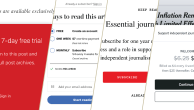The commons of the tragedy
In the days immediately following the September 11 terror strikes on the World Trade Center and the Pentagon the number of Americans online dropped. But there were signs by the end of September that online activity was returning to the usual levels.
At the same time, there were conspicuously more Internet users getting news online after September 11 than in previous periods. More than two-thirds of Internet users (69%) have used the Web to get news and information related to the attacks and their aftermath. Half of Internet users – more than 53 million people – have gotten some kind of news about the attacks online. Many online Americans have used the Internet to stay “on alert” for news developments by subscribing to email news updates and getting newscasts streamed to their desktops. Among those watching developments most carefully online are 33% of Internet users who have gotten information about the financial markets because of their concern about the economic impact of the terror strikes against America.
Perhaps the most significant development online after the attack has been the outpouring of grief, prayerful communication, information dissemination through email, and political commentary. Nearly three-quarters of Internet users (72%) have used email in some way related to the events – to display their patriotism, contact family and friends to discuss events, reconnect with long-lost friends, discuss the fate of the victims, and share news.
Others have gone to the virtual commons in chat rooms, bulletin boards, commemorative sites, and other online communities to describe their anguish, offer consoling words, broadcast their patriotism, and debate, even yell at times, about the meaning of September’s events. A third of Internet users (33%) have read or posted material in chat rooms, bulletin boards, or other online forums and most report that those virtual commons were civil, rational places. Another 12% have gone to commemorative sites, many of which were created in the wake of the attack.
As e-newsletter writer David Weinberger wrote on September 27: “Now, for the first time, the nation and the world could talk with itself, doing what humans do when the innocent suffer: cry, comfort, inform, and, most important, tell the story together.”
This response online was part of a larger collective experience. An astonishing 94% of all Americans – Internet users and non-users alike – have taken at least one step to respond personally to the assault on the World Trade Center and Pentagon. Some people have taken multiple steps:
- 78% have displayed an American flag at their home or business or elsewhere
- 58% have contributed to relief efforts; 3% of Internet users (more than 3 million Americans) have made donations to those relief efforts online
- 48% have attended a religious service
- 17% have tried to donate blood
- 10% have attended meetings about the attacks or their aftermath
It is important to stress that for all of the online activity that focused on the terror assaults, this was not a breakthrough moment for use of the Internet compared to other technologies, as some have argued. There was not a flight to new technologies from TV as a news source or from the phone as a communications tool. Indeed, there was heavy reliance on TV and the telephone even among the most committed and active Internet users.
The findings presented here come from two periods of phone survey work by Princeton Survey Research Associates for the Pew Internet & American Life Project. Both were done before last weekend’s U.S. attacks on the Taliban regime in Afghanistan. The most recent findings cited here come from a survey done from September 20 through October 1, involving 1,029 adults 18 and over in the continental United States. Some 525 of them are Internet users. The margin of error on the entire sample is plus or minus four percentage points and on the Internet users is plus or minus 6 points. Some other findings come from a survey fielded from September 12 through September 19, involving 2,039 adults, some 1,138 of whom are Internet users. In that sample the margin of error is plus or minus two percentage points for the entire sample and plus or minus three points for the Internet users.
This report also cites Web traffic data from comScore Networks, a research firm in Reston, Virginia, that provides Internet usage intelligence to the public and private sectors based on a sample of 1.5 million global opt-in users. That data was made available at the request of the Pew Internet & American Life Project. Further information about that material can be provided by Dan Hess at 312-775-6477 and dhess@comscore.com. The firm’s Web site is: http://www.comscore.com/.




